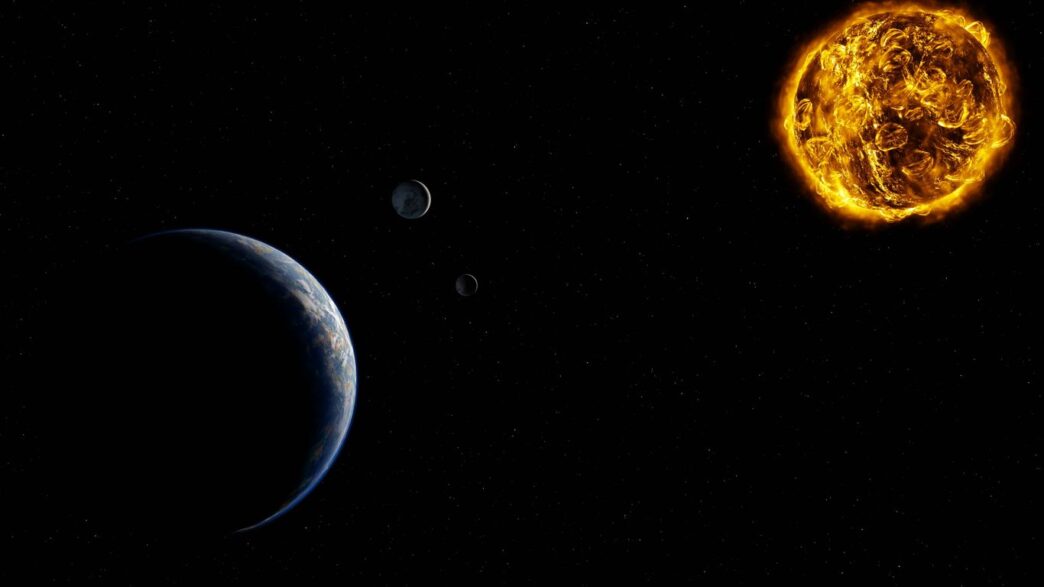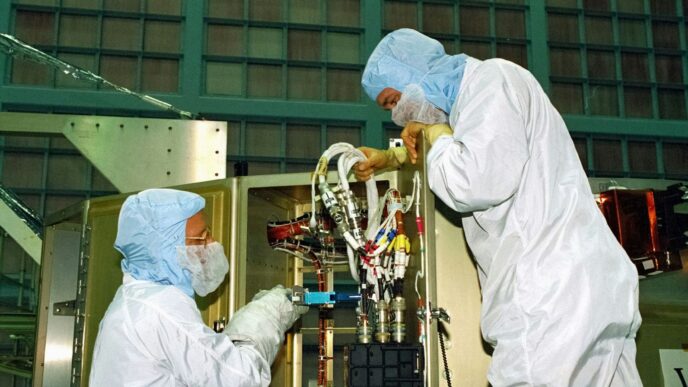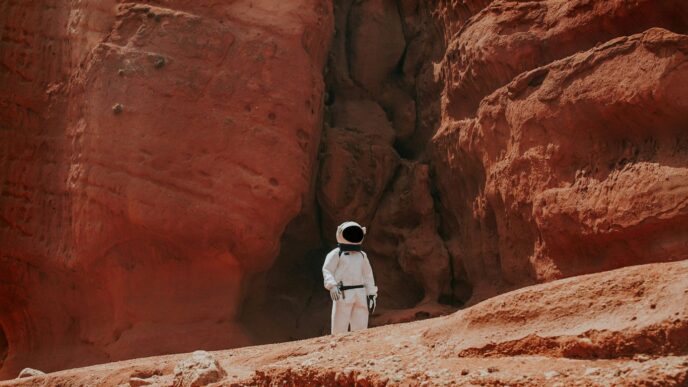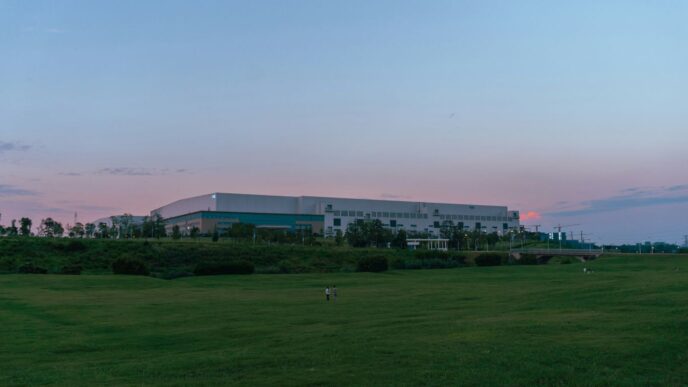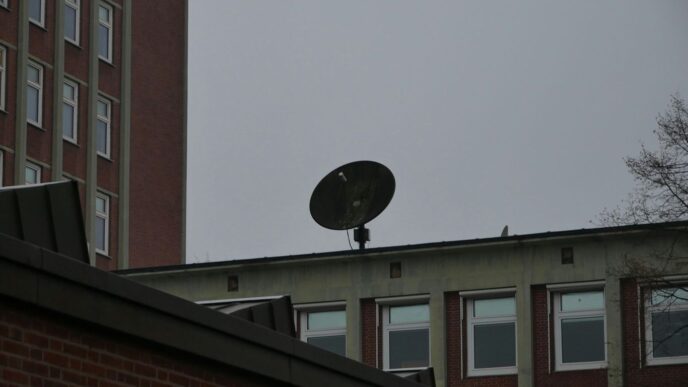Understanding The Natural Satellite

When we talk about space, the word "satellite" often brings to mind those shiny, complex machines we launch into orbit. But here’s a fun fact: our own planet Earth is a satellite, and so is the Moon! Basically, anything that circles around a larger celestial body, like a planet or a star, is considered a satellite. The path it takes is called an orbit, and it’s usually a repeating, curved journey. So, while we often think of the artificial ones we build, the universe is full of natural satellites.
Defining A Natural Satellite
A natural satellite is simply a celestial object that orbits a planet or a smaller body. Unlike the ones we build and send up, these are formed by natural processes. They aren’t launched; they just are. Think of them as cosmic companions that have been around for ages, held in place by the gravitational pull of the larger object they orbit.
Earth’s Moon As A Natural Satellite
Our Moon is probably the most familiar natural satellite to us. It’s been orbiting Earth for billions of years. It’s not just a pretty face in the night sky, either. The Moon plays a pretty big role in things like ocean tides and even seems to help keep our planet’s tilt stable. It’s a constant presence, a silent observer of everything happening down here.
Distinguishing From Artificial Satellites
This is where it gets interesting. While both natural and artificial satellites orbit a larger body, their origins are completely different. Natural satellites, like moons, are formed through cosmic events. Artificial satellites, on the other hand, are built by humans and launched into space. They have specific jobs, like taking pictures of Earth, helping with GPS, or studying distant stars. They’re machines with a purpose, whereas natural satellites are just part of the universe’s grand design.
Here’s a quick rundown:
- Natural Satellites:
- Formed by natural processes (e.g., accretion, capture).
- Examples: Earth’s Moon, Jupiter’s moons.
- Orbit planets or dwarf planets.
- Artificial Satellites:
- Man-made objects.
- Launched by rockets.
- Examples: Hubble Space Telescope, GPS satellites, weather satellites.
- Designed for specific tasks.
The Physics Of Orbital Motion
So, how do these celestial bodies, like our Moon, actually stay up there and keep going around and around? It all comes down to some pretty neat physics, mostly thanks to Sir Isaac Newton. He figured out that there’s this invisible force, gravity, pulling everything towards everything else. If a satellite, like a moon or a spacecraft, was just floating in space with nothing pulling on it, it would just keep going in a straight line forever at the same speed. That’s inertia for you. But planets are big, and their gravity is strong. So, this constant pull from the planet is what keeps the satellite from flying off into the void. It’s like a cosmic tug-of-war between the satellite’s tendency to go straight and the planet’s pull trying to bring it closer.
Newton’s Laws And Gravitational Pull
Newton’s big idea was that gravity isn’t just something that keeps us on the ground; it’s a universal force. Every object with mass attracts every other object with mass. The more massive the objects and the closer they are, the stronger this pull. For a satellite orbiting a planet, this gravitational pull is the key. It’s constantly tugging the satellite towards the planet’s center. Without this force, the satellite would just zoom off in a straight line, thanks to inertia. But because of gravity, the satellite’s path is bent, creating that curved orbit we see. It’s this balance that’s so important.
Elliptical Orbits And Speed Variations
Now, orbits aren’t always perfect circles. Often, they’re more like squashed circles, called ellipses. Think of an oval shape. In an elliptical orbit, the planet is at one of the two focal points of the ellipse, not right in the center. This means the distance between the satellite and the planet changes as it goes around. When the satellite is closest to the planet (that’s called perigee), gravity is strongest, and the satellite speeds up. When it’s farthest away (apogee), gravity is weaker, and the satellite slows down. It’s a constant dance of speed changes.
Here’s a quick look at how speed changes in an elliptical orbit:
| Position in Orbit | Distance from Planet | Gravitational Pull | Satellite Speed |
|---|---|---|---|
| Closest (Perigee) | Minimum | Strongest | Fastest |
| Farthest (Apogee) | Maximum | Weakest | Slowest |
The Balance Between Inertia And Gravity
So, the whole orbiting thing is really about a delicate balance. You have inertia, which is the satellite’s desire to keep moving in a straight line at a constant speed. Then you have gravity, the planet’s pull trying to yank the satellite towards itself. If gravity were too weak, the satellite would fly away. If gravity were too strong, the satellite would spiral down and crash into the planet. The specific speed and distance of the satellite create a situation where the gravitational pull continuously bends the satellite’s path, keeping it in a stable orbit. It’s a constant state of falling, but always missing the planet.
Roles Of Natural Satellites
When we talk about satellites, we often picture those shiny, man-made contraptions whizzing around Earth. But let’s not forget the OG satellites – the natural ones! These celestial bodies, like our very own Moon, play a surprisingly big part in how planets behave. They’re not just pretty to look at; they’re active players in the cosmic dance.
Gravitational Influence On Planets
Natural satellites, especially larger ones, exert a significant gravitational pull on their parent planets. This pull isn’t just a gentle tug; it can influence a planet’s rotation and even its orbit over long periods. Think of the Moon’s effect on Earth – it’s a constant gravitational interaction that shapes our planet in subtle but important ways. This gravitational tug-of-war is a key factor in the stability of planetary systems.
Stabilizing Planetary Axial Tilt
One of the most critical roles a large natural satellite can play is stabilizing a planet’s axial tilt. Earth’s Moon, for instance, acts like a cosmic gyroscope. It keeps our planet’s tilt relatively steady, preventing wild swings that could lead to extreme climate changes. Without the Moon, Earth’s axis might wobble much more dramatically, making long-term habitability a much trickier proposition. Imagine seasons that changed drastically year to year – that’s the kind of chaos a stable tilt helps us avoid.
Tidal Forces And Their Effects
Perhaps the most noticeable effect of natural satellites is the creation of tides. The gravitational pull of a satellite, like the Moon on Earth, is stronger on the side of the planet facing it and weaker on the opposite side. This difference in pull stretches the planet, particularly its oceans, creating bulges that we experience as high tides. These tidal forces have shaped coastlines, influenced marine ecosystems, and even played a role in the evolution of life on Earth. It’s a constant, powerful interaction that reminds us of the Moon’s presence every single day.
Observing The Cosmos With Satellites

When we talk about observing the universe, our minds often jump to giant telescopes on mountaintops or maybe even the ones in space like Hubble. But there’s a whole fleet of artificial satellites up there doing incredible work, not just looking out into the deep dark, but also looking back at our own home planet and helping us understand it better. It’s pretty amazing when you think about it.
Earth Observation Satellites
These are the eyes in the sky that keep a constant watch on Earth. They’re like super-powered cameras and sensors that circle our planet, gathering all sorts of data. Think about tracking ice melt in the Arctic, watching forests for signs of disease or fire, or mapping out changes in coastlines. These satellites provide us with a planetary-scale perspective that’s impossible to get from the ground. They help scientists understand complex systems like climate change, monitor natural resources, and even help with disaster response by showing us the extent of floods or wildfires.
Here’s a peek at what they do:
- Climate Monitoring: Measuring atmospheric gases (like carbon dioxide), tracking ocean temperatures, and observing ice cover.
- Environmental Watch: Detecting deforestation, monitoring agricultural health, and spotting pollution.
- Disaster Management: Assessing damage from earthquakes, tracking hurricane paths, and aiding in search and rescue efforts.
Space Exploration Satellites
While Earth observation satellites focus on our home turf, others are designed to venture further out. These are the probes and observatories that travel to other planets, fly past asteroids, or simply park themselves in orbit to get a better view of distant stars and galaxies. They’re our robotic emissaries, sending back pictures and data from places we can only dream of visiting ourselves. Missions like the Mars rovers, or orbiters around Jupiter and Saturn, are all part of this effort. They help us piece together the history of our solar system and search for clues about whether life exists elsewhere.
Telescopes In Orbit
And then there are the space telescopes. These are a special class of satellite, designed specifically to capture light and other forms of radiation from the universe without the interference of Earth’s atmosphere. The atmosphere, while great for breathing, can distort and block certain types of light, making ground-based observations less clear. Telescopes like the Hubble Space Telescope, and now the James Webb Space Telescope, have revolutionized our understanding of everything from nearby planets to the most distant galaxies. They allow us to see further back in time and with greater detail than ever before, revealing the universe in ways we never thought possible.
Technological Advancements From Satellites
It’s pretty wild when you think about it, but a lot of the tech we use every single day actually got its start because we wanted to explore space. Satellites, in particular, have been a huge game-changer. They’re not just up there looking pretty; they’re doing some seriously important work that makes our lives easier and safer.
Communication and Navigation Systems
Remember when long-distance calls were a big deal? Or when getting lost meant unfolding a giant paper map? Satellites changed all that. They form the backbone of global communication, letting us chat with people across the world instantly. And then there’s GPS. That little blue dot on your phone’s map? That’s thanks to a whole network of satellites working together. It’s not just for finding your way to a new restaurant; GPS is vital for shipping, aviation, and even precision farming.
Here’s a quick look at how some of these systems work:
- Communication Satellites: These act like relay stations in the sky. They pick up signals from one part of Earth, boost them, and send them back down somewhere else. This is how satellite TV and international phone calls happen.
- Navigation Satellites (like GPS): A constellation of satellites constantly sends out signals. Your receiver (like in your phone or car) listens to signals from at least four satellites to figure out your exact location.
- Broadcast Satellites: These are used for things like direct-to-home television, beaming channels right to your satellite dish.
Weather Forecasting and Climate Monitoring
Looking up at the sky to guess the weather is a thing of the past, mostly. Satellites give us an incredible bird’s-eye view of our planet’s atmosphere. They can track storms as they form, measure cloud cover, and monitor ocean temperatures. This information is super important for predicting weather patterns, which helps us prepare for everything from heatwaves to hurricanes.
Beyond daily forecasts, satellites are also key to understanding climate change. They measure things like greenhouse gas levels, ice cap melt, and sea-level rise over long periods. This data helps scientists get a clearer picture of what’s happening to our planet.
Some key things satellites monitor for weather and climate:
- Atmospheric temperature and pressure
- Cloud formation and movement
- Ocean surface temperature
- Greenhouse gas concentrations (like CO2)
- Ice extent and thickness
Impact on Everyday Life
It’s easy to forget, but satellites touch our lives in so many ways. Think about online banking, streaming your favorite shows, or even getting emergency alerts. All of these rely on satellite technology in some form. They help emergency services locate people in distress, enable remote work by providing internet access in far-flung areas, and even help manage resources like water and crops more effectively. It’s pretty amazing how these distant machines have become so integrated into our daily routines, making things more connected and informed.
The Search For Life Beyond Earth
This is probably one of the biggest questions we ask ourselves, right? Are we alone out here? It’s a question that’s been around forever, and space exploration is really our best shot at finding an answer. We’re not just looking at planets in our own solar system anymore; we’re looking way, way out there.
Exploring Potentially Habitable Worlds
When we talk about habitable worlds, we’re not just talking about planets that look like Earth. We’re looking for places that might have the right ingredients for life as we know it, or maybe even life that’s totally different from what we see here. Think about places like Mars. We’ve sent rovers like Curiosity and Perseverance to poke around, and they’ve found evidence that water was around a lot more in the past. That’s a big deal because, well, water is pretty important for life on Earth.
Then there are the moons of Jupiter and Saturn. Europa, one of Jupiter’s moons, has a huge ocean under its icy shell. And Enceladus, a moon of Saturn, actually shoots geysers of water into space! These places are super cold and dark, but the idea of liquid water existing there makes them really interesting targets for finding life.
We’re also looking at exoplanets – planets orbiting stars other than our Sun. Telescopes like the James Webb Space Telescope are getting really good at analyzing the atmospheres of these distant worlds. They can look for gases that might be produced by living things. It’s like trying to sniff out life from light-years away.
Searching For Biosignatures
So, what exactly are we looking for? We call them biosignatures. These are basically signs of life. On Earth, life produces certain gases or chemicals that change the environment. For example, the oxygen in our atmosphere is largely a byproduct of plants and algae doing their thing.
When we look at other planets, we’re searching for similar chemical imbalances in their atmospheres. If we see a lot of a gas that shouldn’t really be there in large amounts without something producing it, that’s a potential biosignature. It’s not a slam dunk, mind you. We have to be really careful to rule out any non-biological explanations. It’s a complex puzzle, and scientists are working hard to figure out what counts as a reliable sign.
Here’s a simplified look at what we consider:
- Atmospheric Gases: Looking for gases like oxygen, methane, or even more complex molecules in unusual combinations.
- Surface Features: While harder to detect from afar, things like large-scale changes to a planet’s surface that could be caused by biological activity.
- Organic Molecules: Finding complex carbon-based molecules that are the building blocks of life.
The Significance Of Extraterrestrial Life
If we ever do find evidence of life beyond Earth, even if it’s just simple microbes, it would be one of the most profound discoveries in human history. It would completely change our perspective on our place in the universe. Suddenly, we wouldn’t be the only example of life. It would suggest that life might be common throughout the cosmos.
This discovery would have huge implications for science, philosophy, and even religion. It would push us to understand life itself in a whole new way. Are there different kinds of life? How does it start? These are questions that finding even the simplest alien life could help us answer. It’s a long shot, for sure, but the potential reward – understanding if life is a cosmic accident or a natural outcome – makes the search incredibly worthwhile.
So, What’s the Big Picture?
Looking back at everything, it’s pretty wild how much these celestial bodies, both natural like our Moon and the ones we send up, do for us. They’re not just pretty things to look at in the night sky. Satellites, in their many forms, help us understand our own planet better, keep us connected, and even guide us when we’re out and about. Plus, they’re our eyes and ears out in the vastness of space, helping us piece together the universe’s story, from our solar system’s neighbors to the farthest reaches we can see. It’s a constant learning process, and these orbiting helpers are right in the middle of it all, showing us more about where we are and what else might be out there.


